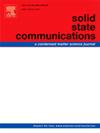Bimetallic CoNi subnanoclusters supported on N-doped graphene as novel CO sensors with improved sensitivity
IF 2.4
4区 物理与天体物理
Q3 PHYSICS, CONDENSED MATTER
引用次数: 0
Abstract
In this work, composites formed by Co6-nNin (n = 0–6) subnanoclusters supported on N-doped graphene (PNG) were theoretically studied as novel CO gas sensors. Firstly, the stabilities of Co6-nNin (n = 0–6) subnanoclusters deposited on PNG were investigated. Then, reactivities of Co6-nNin (n = 0–6)/PNG composites towards the CO detection were investigated. All electronic structure calculations were conducted using the generalized gradient approximation density functional theory. The computed binding energies (Eb) for Co6-nNin (n = 0–6) on the PNG were higher than pristine graphene, suggesting a good stability of the subnanoclusters over PNG. The adsorption energies (Eads) of the CO molecule on the Co6-nNin (n = 0–6)/PNG composites were higher than −1.5 eV, indicating a strong interaction between the CO molecule and the Co6-nNin (n = 0–6)/PNG composites. These results suggest that the composites studied may be good candidates for CO detection.
氮掺杂石墨烯支撑的双金属CoNi亚纳米团簇作为新型CO传感器
在这项工作中,从理论上研究了由Co6-nNin (n = 0-6)亚纳米团簇支撑在n掺杂石墨烯(PNG)上形成的复合材料作为新型CO气体传感器。首先,研究了沉积在PNG上的Co6-nNin (n = 0-6)亚纳米团簇的稳定性。然后考察了Co6-nNin (n = 0-6)/PNG复合材料对CO检测的反应性。所有电子结构计算均采用广义梯度近似密度泛函理论进行。计算得到的Co6-nNin (n = 0-6)在PNG上的结合能(Eb)高于原始石墨烯,表明亚纳米团簇在PNG上具有良好的稳定性。CO分子在Co6-nNin (n = 0-6)/PNG复合材料上的吸附能(Eads)均大于- 1.5 eV,表明CO分子与Co6-nNin (n = 0-6)/PNG复合材料之间存在较强的相互作用。这些结果表明,所研究的复合材料可能是CO检测的良好候选者。
本文章由计算机程序翻译,如有差异,请以英文原文为准。
求助全文
约1分钟内获得全文
求助全文
来源期刊

Solid State Communications
物理-物理:凝聚态物理
CiteScore
3.40
自引率
4.80%
发文量
287
审稿时长
51 days
期刊介绍:
Solid State Communications is an international medium for the publication of short communications and original research articles on significant developments in condensed matter science, giving scientists immediate access to important, recently completed work. The journal publishes original experimental and theoretical research on the physical and chemical properties of solids and other condensed systems and also on their preparation. The submission of manuscripts reporting research on the basic physics of materials science and devices, as well as of state-of-the-art microstructures and nanostructures, is encouraged.
A coherent quantitative treatment emphasizing new physics is expected rather than a simple accumulation of experimental data. Consistent with these aims, the short communications should be kept concise and short, usually not longer than six printed pages. The number of figures and tables should also be kept to a minimum. Solid State Communications now also welcomes original research articles without length restrictions.
The Fast-Track section of Solid State Communications is the venue for very rapid publication of short communications on significant developments in condensed matter science. The goal is to offer the broad condensed matter community quick and immediate access to publish recently completed papers in research areas that are rapidly evolving and in which there are developments with great potential impact.
 求助内容:
求助内容: 应助结果提醒方式:
应助结果提醒方式:


